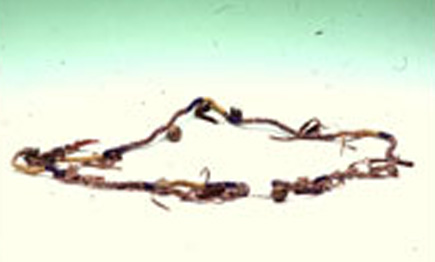Tunic made from four rectangular pieces of black cloth sewn together only at the shoulders and around the sleeve and fastened at the sides and under the sleeves by knotted cotton ribbons. The front and back are each decorated with three discoidal leather appliqués, the central one with a pinwheel motif and the two side ones with concentric circles, made of white, yellow, blue, red, green and blue glass beads. The neckline, both on the front and back, is decorated with two shaped applications made of black cloth with geometric and floral motifs in white, green, red, pink, yellow and azure glass beads bordered by a band of alternating white, azure, pink and yellow glass beads. Along each sleeve is sewn a rectangular blue cloth appliqué bordered by a red ribbon and decorated on the shoulder with a disc in concentric circles and on the arm with a floral motif in white, yellow, red, light and dark green, light blue, silver, pink and blue conteries. On the wrist of each sleeve is sewn a rectangular red cloth appliqué decorated in bands with geometric motifs in green, yellow, white, blue and pink glass beads. Four rectangles of black and brown velvet are sewn in pairs horizontally on the lower part of the sleeve and vertically on the shoulders.
The tunic was part of men's clothing and was originally made of two pieces of tanned deer skin sewn sideways to form a kind of poncho. In a later period, as a result of contact and subsequent trade with whites, the traditional pattern was influenced by the clothing of Europeans and the leather was replaced by fabric. Decorations could be made with fringes, painting, porcupine quills, and glass beads. Decorations varied according to tribe: more sober in the southern plains and richer in the north. This type of floral decoration was of French derivation.













